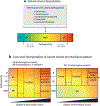Defining the Clinical Value of a Genomic Diagnosis in the Era of Next-Generation Sequencing
- PMID: 27362341
- PMCID: PMC7251520
- DOI: 10.1146/annurev-genom-083115-022348
Defining the Clinical Value of a Genomic Diagnosis in the Era of Next-Generation Sequencing
Abstract
As with all fields of medicine, the first step toward medical management of genetic disorders is obtaining an accurate diagnosis, which often requires testing at the molecular level. Unfortunately, given the large number of genetic conditions without a specific intervention, only rarely does a genetic diagnosis alter patient management-which raises the question, what is the added value of obtaining a molecular diagnosis? Given the fast-paced advancement of genomic technologies, this is an important question to address in the context of genome-scale testing. Here, we address the value of establishing a diagnosis using genome-scale testing and highlight the benefits and drawbacks of such testing. We also review and compare recent major studies implementing genome-scale sequencing methods to identify a molecular diagnosis in cohorts manifesting a broad range of Mendelian monogenic disorders. Finally, we discuss potential future applications of genomic sequencing, such as screening for rare conditions.
Keywords: clinical diagnostics; genomic medicine; monogenic disorders; next-generation sequencing; whole-exome sequencing; whole-genome sequencing.
Figures


References
-
- ACMG Board Dir. 2015. Clinical utility of genetic and genomic services: a position statement of the American College of Medical Genetics and Genomics. Genet. Med 17:505–7 - PubMed
-
- Arora S, Haverfield E, Richard G, Haga SB, Mills R. 2016. Clinical and counseling experiences of early adopters of whole exome sequencing. J. Genet. Couns In press. doi: 10.1007/s10897–015-9876-y - PubMed
Publication types
MeSH terms
Grants and funding
LinkOut - more resources
Full Text Sources
Other Literature Sources
Medical
Research Materials

